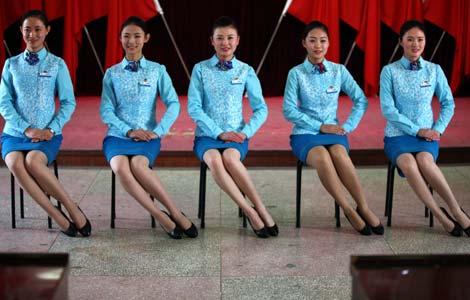Going for 100,000
Updated: 2013-11-21 11:22
By Chen Weihua (China Daily USA)
|
||||||||

|
American students studying at Chongqing University show their cooking skills at an international students' festival at the university. The US and China have agreed to encourage and facilitate more American students to study at Chinese schools. Li Hua / China Daily |
More American students are going to China to study under the 100,000 Strong Initiative and finding it to be a life-changing experience, Chen Weihua reports from Washington.
It was 4 pm and Chinese tea time at the Sigur Center for Asian Studies at George Washington University on a recent Thursday. Caitlin Keliher, a senior, was taking part in a group chat in Chinese led by the center's director Edward McCord, a professor of Chinese history.
The topics were mostly China related, ranging from studying there and learning Mandarin to Chinese warlords in the 1920s, a subject that is McCord's specialty.
Keliher, a double major in economics and Chinese who has studied the language since her final year at a high school in Boston, spent six months last year at the Minzu University of China in Beijing to hone her language skills.
"I had five hours of Chinese language class there every day and the progress was tremendous. But since coming back, my language skill has deteriorated, so I come here to practice," Keliher said in Chinese.
Sitting next to her was Luis Rodriguez, a sophomore majoring in international trade with a minor in Chinese. Also speaking in Chinese, he said he started to learn the language in high school in Miami and plans to study in China next year.
Both Keliher and Rodriguez are among the growing number of American students who have sought to study in China in the past decade, especially since November 2009 when US President Barack Obama announced at a town hall meeting in Shanghai the ambitious goal of sending 100,000 American students to study in China over four years, from 2010 to 2014, citing the strategic importance of US-China relations.
The 100,000 Strong Initiative was formally launched in Beijing in May 2010 by then-Secretary of State Hillary Clinton.
A special report, titled US Students in China, issued by the Institute of International Education (IIE) in January this year predicted that the 100,000 Strong Initiative was likely to meet its goal, assuming a sustained or increased interest in studying in China.
The study showed that there were at least 28,686 American students participating in educational activities in the Chinese mainland, Hong Kong and Macao in 2011.
The report noted that the numbers were almost certainly an undercount since it was likely that many more US students who go to China on their own, often during school breaks, were not being tracked or reported by higher-education institutions.
The 2013 Open Doors report released on Nov 11 by the IIE and the State Department's Bureau of Educational and Cultural Affairs showed that China was the fifth most-popular destination for US students studying abroad in the 2011/12 academic year, trailing Britain, Italy, Spain and France. Overall, about 15,000 US students were studying in China for degree and for-credit programs. But this did not include another approximate 10,000 American students going to China each year for short-term, no-credit language and volunteer programs.
While the US has no official figure for the total number of US students going to China on all types of programs, China's Minister of Education Yuan Guiren put the number of US students studying in China in the first three years of the 100,000 Strong Initiative at 67,543.
Carola McGiffert is president of the 100,000 Strong Foundation, a not-for-profit organization that was set up in January this year to help expand and diversify the number of American students studying Mandarin and studying in China.
She told China Daily that while the foundation awaits the figure for the 2013 school year, she also is optimistic about reaching the target.
For the past decade, the number of American students studying in China for academic credit from their US home institutions climbed an average of 18 percent each year from 3,291 students in 2000 to 15,647 in 2010/2011, nearly fivefold the 2000 figure.
The IIE study in January also found that 76 percent of all US students in China pursuing for-credit and not-for-credit education were undergraduates, 21 percent were graduate students and a little more than 3 percent associate degree and non-degree students.
Most popular programs
Study programs for credit in China continue to be the most popular, and study tours were the second-most popular way to get an educational experience in China. Meanwhile, several thousand students took part in more extended academic and language course work in China, with some engaged in internships, international volunteering and service-learning projects.

McGiffert said that due to the language barrier, American students are not now going to China for degree programs.
"But we think it's important to have any sort of exposure to China," she said. "Whether summer program, or semester or a year abroad, learning the culture, learning the language, getting a deep sense of Chinese history, politics and economics is critical to ensure our next generation of leaders from this side understand China and are able to manage the relationship effectively and move it forward."
Allison Lee attended a semester-long program in Shanghai in the spring of 2010 when she was a New York University undergraduate.
Besides learning the language, getting an insight into China by taking courses on contemporary China and law and society and having an internship with a web-based publication, she also traveled with friends to Hangzhou and the Yellow Mountains.
"For me personally, the daily scenes are what I hold closest to my heart," she said. "Sitting on a makeshift bench attached to a soup station, which was attached to a peddler bike, eating noodles that tasted like nothing I've had before, and watching the evening pass was an activity that I never tired of."
"Conversation in Chinese with vendors and fellow customers was basic, but always comical, and solidified my belief in the kindness of the Chinese people," said Lee, who is half Chinese, but did not speak Chinese originally and did not have family or friends in Shanghai.
She said her perception of China from the media was that of a single unified entity.
"In living here, that idea was completely shattered as I came to learn of the immense diversity of people, ideas and lifestyles," said Lee, who returned to China just two months ago to continue studying Chinese and immersing herself back into Chinese culture.
"There is no question in my mind that any future study or career will include a focus on China and international relations," she said.
For Keliher who spent six months in Beijing in the program called Associated Colleges in China run by Hamilton College in New York, highlights of the trip included improving her Chinese language skills, making friends with Chinese college students and traveling across the country.
"I really enjoyed when my aunt visited me in Beijing for 10 days and I had the opportunity to show her around the city," Keliher said. "It was also unique being in China for the US presidential election, watching the presidential debates with other Americans in Beijing and experiencing how the Chinese media reported the election."
Keliher believes that after living in Beijing, she has a greater understanding of and appreciation for Chinese culture.
"The Chinese professors at Minzu University were so very intense and demanding. After studying Chinese for six months, I am confident in my language abilities and am excited to return to China to use my Chinese," she said.
Keliher did return this past summer and spent seven weeks in southwest China's Yunnan province conducting research on rural education and women's development.
"My senior economics thesis will analyze trends in rural education development in China. In the future, I would like to pursue a China-related career," she said. "I think studying in China for an extended period of time was the best way to improve my Chinese skills, and I am very excited to return to China in the future."
Unlike Keliher and Lee, Megan Elliott from the Muscatine Community College along the Mississippi River in Iowa was among a much smaller percentage of Americans from community colleges and high schools involved in education activities in China.
She spent one month in a school in Hangzhou of east China's Zhejiang province this past summer with seven other students from the community college, five from Muscatine High School and three adult chaperones. The study program under the 100,000 Strong Initiative was funded by Wanxiang America, a Chinese-owned auto-parts maker.
"This trip definitely inspired me to learn much more about China and its history," said Elliott. "Most likely, I will be encouraged to keep learning and watching what is happening in China, because now, in a way, I have a tie or a bond with China."
Never left Iowa
For Elliott, who had never left home in Iowa, she acknowledged missing her family and friends during that month in China.
"It was hard to be away from everyone that long; however, I am glad that there were others there from my school that went along," she said.
For Keliher, life in Beijing was not always pleasant. "The pollution was terrible. I enjoy running outside and was unable to do so," she said, adding that on some days several students with asthma had difficulty breathing.
Lee described the NYU program in Shanghai as well-run, but she hoped there could be a better integration of Chinese and American students so she would feel less isolated as a "foreign student."
Kirk Martin, director of the Chinese Cultural Exchange Program at Drake University in Des Moines, Iowa, said while students' previous experience with China and the Chinese language is far greater than it has ever been, many students still have a sense that studying in China is much more challenging personally and academically than studying elsewhere, especially in English-speaking countries.
Martin said there are more Drake University students studying Chinese language and studying in China than ever before. While Drake still does not have a Chinese major, it has developed a variety of programs about China both on and off campus.
At GWU in Washington, a few more than 100 students study in China each year while 1,000 take Chinese classes, according to McCord.
McGiffert of the 100,000 Strong Foundation said the Chinese government and universities have made great efforts to increase the number of English classes for American students so they can take intensive Mandarin and keep up other course work.
The foundation is launching an ambassador program for young Americans who have studied in China to talk about why the experience has been life transforming for them.
"We are also working at the state and local level with governors and mayors on how to better integrate Mandarin learning," McGiffert said.
She believes as Americans improve their Chinese language skills, there will be more American students going to China for one year or one semester programs.
Besides increasing the number of students studying in China, the foundation is also emphasizing diversity to ensure that students from under-represented communities and racial and ethnic minorities can take advantage of the opportunity to study in China.
The US government and universities offer various scholarships to study in China. McGiffert said the US is grateful to the Chinese government for providing 20,000 scholarships to American students to study in China under the 100,000 Strong Initiative.
Schwarzman's donation
Wall Street mogul Stephen Schwarzman, founder of the Blackstone Group, announced in April an effort to raise $300 million, including $100 million of his own money, to start a program at Tsinghua University in Beijing, something like the Rhodes Scholarship program. On Oct 24, a residential college building for the program broke ground in Beijing.
When operational in 2016, the program will bring 200 students a year to China - 45 percent from the US, 20 percent from China and 35 percent from the rest of the world.
On Nov 21, the 100,000 Strong Foundation's annual conference at American University in Washington, its hosting school, will try to garner more support by bringing together some 200 people from think tanks, schools, businesses and government to highlight the importance of US-China relations and investing in the young generation.
Secretary of State John Kerry and Chinese Vice-Premier Liu Yandong will both address the conference, which coincides with the Fourth China-US High-Level Consultation on People-to-People Exchange to be held in Washington that day.
McGiffert noted that it is nearing the fourth anniversary of Obama's announcement of sending 100,000 American students to study in China. "The relationship is too critical to leave anyone out," she said.
Contact the writer at chenweihua@chinadailyusa.com
(China Daily USA 11/21/2013 page9)

 Oil pipeline blast leaves 22 dead in E China
Oil pipeline blast leaves 22 dead in E China
 Good couples get better
Good couples get better
 More than 9m Syrians need humanitarian aid
More than 9m Syrians need humanitarian aid
 50th anniversary of the assassination of Kennedy
50th anniversary of the assassination of Kennedy Blueprint tightens EU links
Blueprint tightens EU links
 Beckham promotes bodywear in Shanghai
Beckham promotes bodywear in Shanghai
 Service seminar for E China train attendants
Service seminar for E China train attendants
 Kennedy cousin Skakel poised for prison release
Kennedy cousin Skakel poised for prison release
Most Viewed
Editor's Picks

|

|

|

|

|

|
Today's Top News
Wang named Asia's businessman of the year
Bitcoin rollercoaster hits China
US President sets new date for Asia visit
Bid to boost people ties
Manufacturing PMI seen moderating in Nov
Kennedy cousin Skakel poised for prison release
'Tapering' of QE would benefit world
Blueprint tightens EU links
US Weekly

|

|







